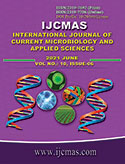


 National Academy of Agricultural Sciences (NAAS)
National Academy of Agricultural Sciences (NAAS)

|
PRINT ISSN : 2319-7692
Online ISSN : 2319-7706 Issues : 12 per year Publisher : Excellent Publishers Email : editorijcmas@gmail.com / submit@ijcmas.com Editor-in-chief: Dr.M.Prakash Index Copernicus ICV 2018: 95.39 NAAS RATING 2020: 5.38 |
Glyphosate is a non-selective herbicide that is commonly used to combat a wide range of annual and perennial weeds. However, its widespread use has negative consequences for human beings and for the climate change. Aside from that, it has an effect on marine organisms, microbial biota in soil, which leads to a lack of soil fertility, and eventually reduces plant growth and yield, all of which has an impact on the food chain. Various methods have been used to eliminate glyphosate from polluted environments, but the most eco-friendly and cost-effective alternative is microbial degradation and the use of nitrogen, either singly or in combination with organic sources. Microbes release basic elements in the soil by their enzymatic processes, and they play an important role in improving plant growth and phytoremediation capacity by lowering the total toxicity of a pollutant to plants. Furthermore, dehydrogenase and urease processes, which are known to be the most critical measures of overall microbial development, are greatly influenced by nitrogen fertilizers. Hence, the effect of glyphosate should be analyzed in order to establish a conservation and management strategy to mitigate glyphosate toxicity of aquatic ecosystems, plant growth, and habitats, as stated above.
 |
 |
 |
 |
 |